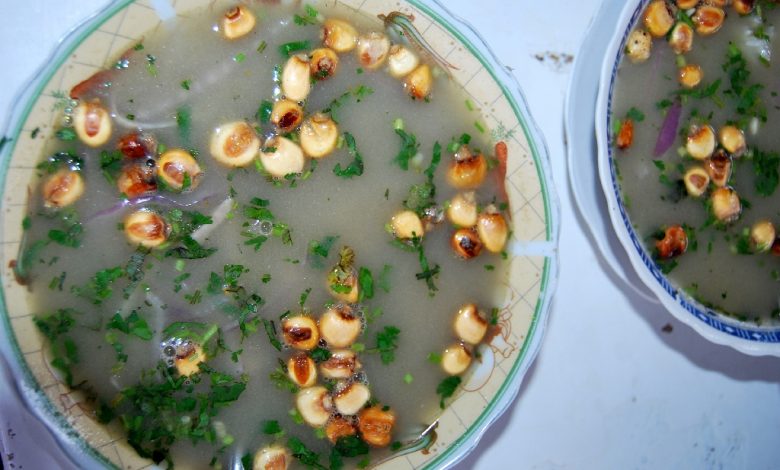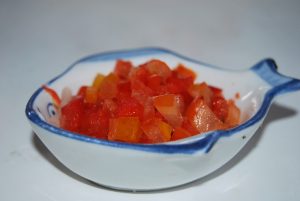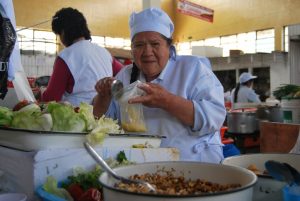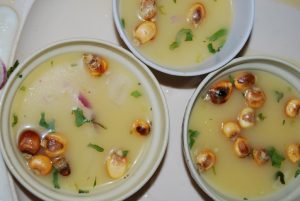Wake the Dead with Fish Soup, Chilcano

While the ancient, Inca city of Cuzco is known for its indigenous Andean food, it also has food that originates on the coast. Even in Inca times, there were tales of ch’askis, runners, bringing fresh seas food from the coast to the inca capital. Now a days airplanes perform that task. As a result, the people of Cuzco have developed a taste for fresh ceviche–fish “cooked” in lime juice–and a seafood soup called chilcano. These are exquisite when prepared well and delight the palate of Cuzco’s people.
Chilcano is sea food broth much loved in the city of Cuzco, where soups and broths have great demand and are a corner stone of the city’s gastronomic edifice. It is made from the heads of Peruvian jack mackerel, called jurel, along with other species. To this is added lots of Peruvian limes juice, toasted corn–cancha–-and a fragrant herb such as cilantro. With these ingredients a magical broth develops that pleases the palate and leave an incredibly fresh aftertaste. People like it hot. It has energizing properties, given its high quanitity of proteins.
Almost everyone in the city consumes this concentrated broth, though students who depend on their brain power are particularly dedicated. After long hours of classes get through they will immediately go to a cevichería for a bowl of this soup. By Cuzco’s San Antonio Abad university their is a whole long row of cevicherías that meet the demand for this invigorate ing broth and fresh ceviche. The vendors have a special ceviche, just for the students, they call “student’s ceviche” (ceviche universitario). It costs 2 soles, about $0.80US, a very economical price so that everyone at the University can enjoy this comforting dish that is filled with energy.
Chilcano, a by product of ceviche, is known as “raise-the-dead”. People gave it that name because after a long night of drinking and partying, or after a social obligation where people drink a lot of beer, people know that when they awaken with the aches and pains of a hang over it is good to go have a chilcano. “Let’s go chilcanear” they say, “let’s chilcano,” as if this noun were a verb that changes you. When prepared well, like some of the best places do, and accompanied by a good ceviche, it a cures hang over quickly.

In general the wholesalers of fish bring them from Lima. Different varieties of fish arrive every day. Each is used in a particular way and for certain dishes. For example, the jack mackerel along with others are used for ceviche, while the kingfish finds it way into fried fish accompanied by huayro potatoes, rice, and large ears of fresh corn.

The fish broth is served as a first course, an entrance which–like a rite of passage– starts you on your way to being filled with energy. It is said that it “awakens” the palate and “opens” appetite, with its strong “leche de tigre” (tiger’s milk) a miture of lime and fish juices, its parched corn (cancha), and the asnapa (minced herb) which is placed at the end to give color and a bit more aroma.
After the chilcano, people tend to serve a ceviche, with fried rice, more cancha, and minced aspana herbs to decorate the plate. People love to devour it, especially since it is served at a very economical price in this city where wages are not very high. Many vendos will also make specially concentrated chilcanos for hang overs (resaca).

One of the places here they make a partier’s chilcano is found in Rosas Pata. A lady named Alicia Chavez who for decades has enchanted people. She prepared the most incredible chilcano of the area. The people who live in this neighborhood near the university and the populous zones on the nearby hillsides call her’s the best chilcano. As soon as she opens her stand, people quickly arrive and they begin calling out for chilcano. Mrs. Garcia has to satisfy all of them and have them go away content and grateful for her concentrated chilcano with a delicious glass of chicha morada, all for a ocuple of coins.
After a night of partying both youth and adults know that they next day you go there to have a delicious and concentrated chilacno made from fish heads to “cure” your head. This is an important part of Cuzco’s folk wisdom and culture.





